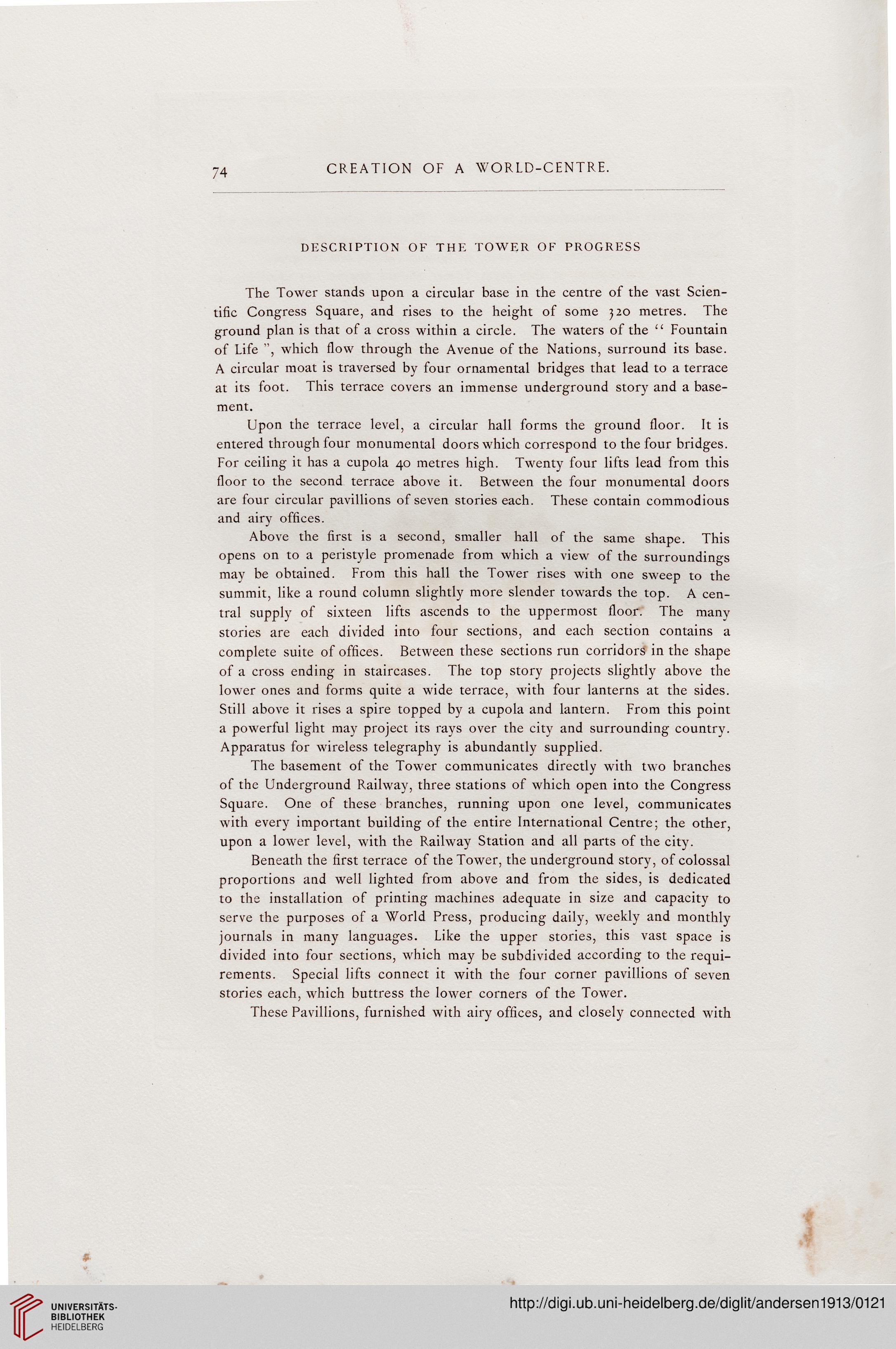74
DESCRIPTION OF THE TOWER OF PROGRESS
The Tower stands upon a circular base in the centre of the vast Scien-
tific Congress Square, and rises to the height of some 320 metres. The
ground plan is that of a cross within a circle. The waters of the " Fountain
of Life which flow through the Avenue of the Nations, surround its base.
A circular moat is traversed by four ornamental bridges that lead to a terrace
at its foot. This terrace covers an immense underground story and a base-
ment.
Upon the terrace level, a circular hall forms the ground floor. It is
entered through four monumental doors which correspond to the four bridges.
For ceiling it has a cupola 40 metres high. Twenty four lifts lead from this
floor to the second terrace above it. Between the four monumental doors
are four circular pavillions of seven stories each. These contain commodious
and airv offices.
Above the first is a second, smaller hall of the same shape. This
opens on to a peristyle promenade from which a view of the surroundings
may be obtained. From this hall the Tower rises with one sweep to the
summit, like a round column slightly more slender towards the top. A cen-
tral supply of sixteen lifts ascends to the uppermost floor. The many
stories are each divided into four sections, and each section contains a
complete suite of offices. Between these sections run corridors in the shape
of a cross ending in staircases. The top story projects slightly above the
lower ones and forms quite a wide terrace, with four lanterns at the sides.
Still above it rises a spire topped by a cupola and lantern. From this point
a powerful light may project its rays over the city and surrounding country.
Apparatus for wireless telegraphy is abundantly supplied.
The basement of the Tower communicates directly with two branches
of the Underground Railway, three stations of which open into the Congress
Square. One of these branches, running upon one level, communicates
with every important building of the entire International Centre; the other,
upon a lower level, with the Railway Station and all parts of the city.
Beneath the first terrace of the Tower, the underground story, of colossal
proportions and well lighted from above and from the sides, is dedicated
to the installation of printing machines adequate in size and capacity to
serve the purposes of a World Press, producing daily, weekly and monthly
journals in many languages. Like the upper stories, this vast space is
divided into four sections, which may be subdivided according to the requi-
rements. Special lifts connect it with the four corner pavillions of seven
stories each, which buttress the lower corners of the Tower.
These Pavillions, furnished with airy offices, and closely connected with
DESCRIPTION OF THE TOWER OF PROGRESS
The Tower stands upon a circular base in the centre of the vast Scien-
tific Congress Square, and rises to the height of some 320 metres. The
ground plan is that of a cross within a circle. The waters of the " Fountain
of Life which flow through the Avenue of the Nations, surround its base.
A circular moat is traversed by four ornamental bridges that lead to a terrace
at its foot. This terrace covers an immense underground story and a base-
ment.
Upon the terrace level, a circular hall forms the ground floor. It is
entered through four monumental doors which correspond to the four bridges.
For ceiling it has a cupola 40 metres high. Twenty four lifts lead from this
floor to the second terrace above it. Between the four monumental doors
are four circular pavillions of seven stories each. These contain commodious
and airv offices.
Above the first is a second, smaller hall of the same shape. This
opens on to a peristyle promenade from which a view of the surroundings
may be obtained. From this hall the Tower rises with one sweep to the
summit, like a round column slightly more slender towards the top. A cen-
tral supply of sixteen lifts ascends to the uppermost floor. The many
stories are each divided into four sections, and each section contains a
complete suite of offices. Between these sections run corridors in the shape
of a cross ending in staircases. The top story projects slightly above the
lower ones and forms quite a wide terrace, with four lanterns at the sides.
Still above it rises a spire topped by a cupola and lantern. From this point
a powerful light may project its rays over the city and surrounding country.
Apparatus for wireless telegraphy is abundantly supplied.
The basement of the Tower communicates directly with two branches
of the Underground Railway, three stations of which open into the Congress
Square. One of these branches, running upon one level, communicates
with every important building of the entire International Centre; the other,
upon a lower level, with the Railway Station and all parts of the city.
Beneath the first terrace of the Tower, the underground story, of colossal
proportions and well lighted from above and from the sides, is dedicated
to the installation of printing machines adequate in size and capacity to
serve the purposes of a World Press, producing daily, weekly and monthly
journals in many languages. Like the upper stories, this vast space is
divided into four sections, which may be subdivided according to the requi-
rements. Special lifts connect it with the four corner pavillions of seven
stories each, which buttress the lower corners of the Tower.
These Pavillions, furnished with airy offices, and closely connected with





